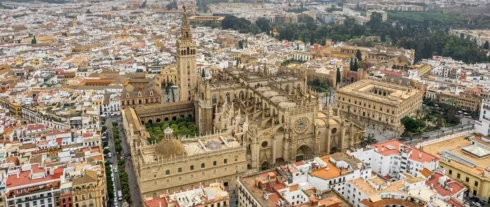The respected travel magazine Lonely Planet named these activities as the top ten Things to Do in Spain’s Andalucia.
Andalucia is the largest region in Spain. It can be difficult to decide what to do.
What should you prioritize? There are many amazing things to see, from world-class natural wonders to cathedrals.
Travel experts Lonely Planet has now released their foolproof guide to the area, which highlights the top 23 attractions.
We have selected the top two locations from each region to give you an overview of what must be seen in Andalucia.
Sevilla, Huelva and Huelva
Topping the list is the ‘awe inspiring’ Gothic cathedral in Sevilla.
The world’s largest Gothic building, the Catedral de Santa Maria de la Sede is a ‘veritable feast of artworks and skilled craftwork’.

Travel magazine: “Flying buttresses adorned with gargoyles, lavish Gothic ornamentation, and cheeky gargoyles adorn the exterior. This is a testament to the power of religious devotion.”
Secondly, they recommended visiting Sevilla’s Giralda tower, where you can ‘look out over rooftops, see important royal tombs and major art treasures.’
La Giralda is also home to major art treasures. These include a Goya, in the Sacristia De Los Calices; a Zurbaran, in the Sacristia Major, and Murillo’s sparkling La Inmaculada, in the Sala Capitular. “The Tomb of Columbus is marked by four figures still hugging the exterior walls, carrying a ornately-carved catafalque,” according to Lonely Planet.
Almeria and Granada
The Alhambra is the most popular attraction in Granada. It’s not surprising that it tops the list of the magazine.
Described as one of the ‘most architecturally perfect buildings in existence’, the Alhambra is Spain’s second most-visited attraction, and with good reason.

“The Moorish fortress of the Palace” Alhambra The fortress is surrounded by defensive walls and sits high over Granada. Alcazaba occupies Alhambra’s western tip, offering unparalleled views of Albayzin and the Sacromonte mountains, as well as Granada’s rooftops”, said Lonely Planet.
“The Museo de la Alhambra has superb tilework. The elaborately carved wood door from the Sala de Dos Hermanas and the excavated remnants of the Acequia Real” (Royal Water Channel) are also featured.
La Geoda de Pulpi, a crystal cave located in the Sierra de Aguilon, was ranked second.
The world’s largest geode is found in the abandoned silver mine near the Murcia border.
The impressive natural phenomenon, measuring eight metres in length and two metres high, can be visited by a guide.
The tours take you into tunnels that are glistening in mineral deposits, and will show you a cathedral cavern complete with a spiral staircase. The tour de force is the descent 50m (164 ft) below the surface, where you get to climb inside the actual geode – a giant crystal resembling a sparkling cave,” stated the magazine.
Cadiz & Gibraltar
Western Andalucia is finally getting the recognition it deserves, with many tourists exploring the virgin Costa de la Luz and venturing into the curious area that is the ‘Rock’.
Lonely Planet’s top pick in the region is a tour to a Cadiz bodegas. Sherry, a drink that British grandmothers love, hails from Andalucia.
Bodega Manuel Aragon provides a 90 minute visit that includes a walk through the vineyards, tasting and an explanation of how sherry is made.

They also recommended a trip to Peña Flamenca La Perla, ‘one of the original homes of flamenco’.
Set in the ‘romantic’ Barrio de Santa Maria, the magazine recommends visiting on a Friday night when the ‘cavernous venues fills up with aficionados.’
Stay till 10pm, when the ‘spellbinding’ Miri ‘Perlita’ Galeano takes to the stage accompanied by intense guitar and skilled footwork.
Cordoba y Jaen
Cordoba and Jaen have some of the most beautiful cultural sites in Spain.
First on Lonely Planet’s list is ‘Moorish marvel’ that is the Mezquita de Cordoba.

The Mezquita ranks among the world’s finest buildings. The magazine suggested that with so many places to visit, you should take your time.
Lonely Planet also recommends visiting the Alcazar de los Reyes Cristianos in Cordoba.
Alcazar, like the Mezquita in Seville, has remnants of Moorish, Christian and Roman rule. It also boasts immaculate gardens and Roman mosaics.
A ‘small but fascinating attraction’, the Alcazar has been used as a palace, a military base and a prison, providing a rich history.
Malaga
Malaga’s beach resorts are popular, but it has much more to offer in terms of culture, nature and cuisine.
El Torcal de Antequera is the first on this list. It’s a beautiful natural park located about 10 miles away from the town.

The UNESCO World Heritage Site of Antequera includes the Pena de los Enamorados and dolmens.
The park is almost Martian in appearance, with its bizarre rock formations that rise to the sky, like stacks and layers of pancakes. Mountain goats soar above the pinnacles while graceful vultures scale them. The magazine said that earthquakes caused the mountains to rise over 1300m.
The second Lonely Planet recommendation is the Museo Picasso, which is a far cry from El Torcal.
The museum provides a ‘complete overview’ of Picasso’s creative work, with over 200 works spanning eight decades of the artist’s life.
Housed in the Buenavista Palace, the museum opened in 2003 and since been a bastion of Picasso’s legacy in the city, ‘transforming Malaga into the art and cultural heart of Andalucia.’
 Costa News Spain Breaking News | English News in Spain.
Costa News Spain Breaking News | English News in Spain.





